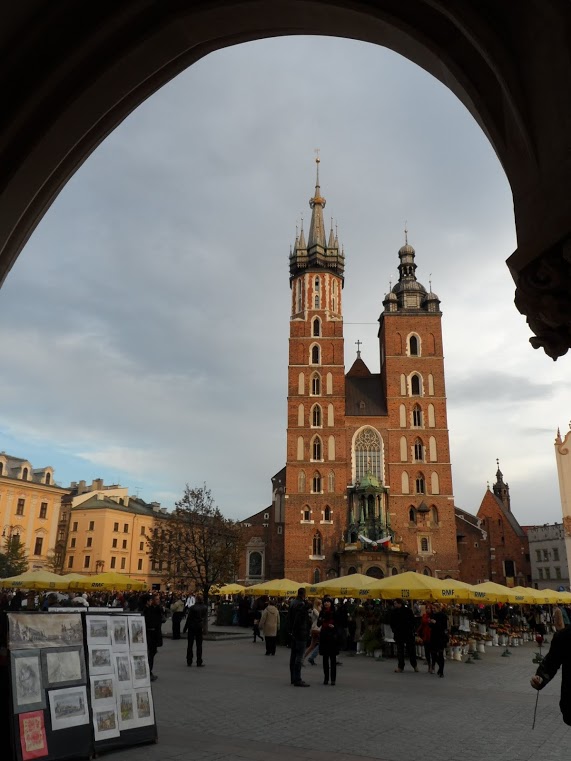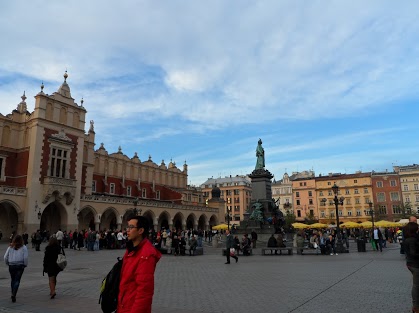We flew into Krakow Poland from Edinburgh in Scotland on November 11, the poignant annual day of Remembrance for the United Kingdom and the Commonwealth countries. It is however the Polish Day of Independence and was marked appropriately. Independent Poland came into being on November 11, 1918 at the very end of the Great War.
This ancient country has been invaded and subsumed over the centuries by neighboring states such as Sweden and Germany, Austria and Russia and little did they know on that day that a nightmare would start for them again only 21 years later.
Now, thankfully Poland is free and democratic and part of the European Union and currently in receipt of a great amount of money to help the country modernize and flourish after years of cruel warfare first wrought by Nazi Germany and then by Communist Russia. How thrilled we in the West were when Poland freed herself just over 20 years ago.
Krakow is now a UNESCO World Heritage city and rightly so and deservedly so. It has the largest medieval market square in the whole of Europe and thankfully all those lovely heritage buildings were not damaged in the last great conflict. The centrally positioned Cloth Hall, a construction from the turn of the 12th century was originally designed for the cloth trade but now is a beautiful heritage mall for the various beautiful Polish products such as amber jewelry, wood carving, woven garments and other goods.
Overlooking the square from the east is St Mary’s Church with its magnificent high altar carved by the sculptor Veit Stoss. Every hour the hejnal (bugle call) is played from the higher tower to commemorate the Tatar raids on the city during the 13th century. I found this incredibly poignant as yet again it demonstrates how this wonderful place has been the victim of aggression through the centuries. The Town Hall tower dominates the western section of the square. 
The overwhelming experience for Graham and me was of welcome and friendliness from staff serving in restaurants and cafes and those one met in the course of four days. We chose to stay in a hotel in Kazimierz which was a shortish walk away from the main square but easily reached by the No 8 tram. Kazimierz is a historical municipality on the outskirts of Krakow and today one of the city’s most up and coming districts. Kazimierz was home to the larger part of the Jewish population of Krakow till 1939.
Here can be found the Remuh Synagogue and the Alte Schule, Poland’s oldest synagogue which today is an important museum of the district. There are of course some lovely churches too and I particularly loved Corpus Christi. The restaurants and bars here are full of character and as we were staying in Josepha Street at the Astoria Hotel…a good three star we gravitated towards Starka.
We were tired, hungry and thirsty on the first afternoon when we arrived and having freshened up we went on to Josepha and looked around and spied Starka. Well, the welcome was shy but enthusiastic and the menu of the day was so enticing … goulash soup followed by escallops of chicken with potatoes and vegetables and a whole choice of desserts washed down with either good Polish beer or mulled wine. We were happy.
Add to this that when departing and paying the bill the owner Joanna pointed out we would need Polish currency for the trams and we only had Euros and firmly lent us the equivalent of £5 sterling…. now where else would someone do that? We repaid that evening and became regular customers throughout our stay. Naturally we went to other places and none of them proved wanting.
The royal castle is located on top of Wawel Hill which commands a view of the whole town. It has been most carefully and beautifully restored; it had suffered at the hands of the Austrians during the 19th century and been completely disrespected by being used as an army barrack.
The origins of this magnificent set of buildings go back to 1000 AD. The whole set of buildings are interesting and unique amongst well kept gardens and one looks down on the Vistula River below or to the town in the distance.
I loved it and was fortunate enough to revisit on a beautiful sunny day – don’t go on Mondays as we did originally because the interior is closed; however we took full advantage of the very few people and visited the Cathedral; it is beautiful and gave us a good idea of Poland’s monarchy through the medieval centuries.
That country has much of which to be proud in terms of culture and heritage. The café is excellent and produced the most stunning chocolate drinks…..Polish chocolate drinks are twice as thick and luxurious as anywhere else!
We attended a chamber music concert in the church of St Peter & St Paul one evening; this church is adjacent to the very old church of St Andrew which is connected to the Poor Clare’s Convent. All of this is really ancient and beautiful and worth lingering over.
The bookshops have lovely cafes and the jewelry designers have some stunning necklaces and pendants. Truly I could have been very greedy but thankfully EasyJet’s miserly luggage stipulation put paid to that!
Just walking by the Vistula on a sunny morning is pleasant and then take a trip on a small launch which is moored alongside an elegant boat restaurant…in the summer of course all the cafes and bistros with a garden terrace must be in high demand. I enjoyed the Polish cuisine and their emphasis on mushroom was appreciated….apparently Poles love to go foraging in their woods for wild mushrooms….hmm as long as they know what they are doing as I would not!
Jazz and popular music is very prevalent and this is a city of many academic institutions with its Jagiellonian University established in 1364 providing a centre for the young to which they gravitate…this resonated with me as Edinburgh is a similar city with four universities and several colleges and that makes for lots of young people and their energy and vitality.
We hired a car and driver and made a pilgrimage to Auschwitz-Birkenau. I am not going to write much but simply say we felt it was our duty to go there and fully understand the horror of what was perpetrated in that place 70 km from Krakow. The cruelty and barbarity seeped into my soul and after two and half hours we had had enough. I stood under the oak tree full of its autumn leaves that seemed to whisper to me and I fancied I heard a squeak and looked at the gibbet on which they hanged the commandant of Auschwitz after his War Crimes trial….it was eerie and upsetting and one does not hear birdsong….a truly terrible place. Birkenau of which we just drove around the perimeter is massive and Andrew our driver was very sensitive. We then drove off to Wieliczka Salt Mine.
Wieliczka Salt Mine is also a UNESCO world heritage site and the only open mining facility in the world working continuously since the Middle Ages. It is a complex of underground excavations consisting of 3,000 chambers of the total length of 300 km at levels from 64 to 327 metres deep. Before we entered the mine however we had a very welcome lunch in Andrew’s favorite restaurant and good it was too…nicely served and so reasonably priced.
Fortified once again we went down the mine. Quite simply it is amazing with these initial 380 steps one has to descend and then a further 200 or so gradually…our legs were aching the next day but be assured there is a lift in which to return!
The miners carved out the most amazing grottos depicting the local history and being very religious there is a great emphasis on the Christian church with some small chapels and then one like a cathedral. Considering that these miners were not artists they had made the most outstanding statues and bas reliefs and even the chandeliers are made of rock salt. Salt was highly prized in the medieval age because it was the only means by which to preserve food and thus as important as gold. Miners though living dangerous hardworking lives became rich and were respected people.
Four days is a good amount of time to spend in Krakow and if one wanted in the summer time a trip to the Tatras that would be lovely too. There are many Christian saints associated with this area of Poland but for those of us now the person of greatest fame would be Pope John Paul II. Whoever you might be of any faith or none this ancient city draws one in and displays its beauty and heritage carefully and that is nicely complimented by the warmth of welcome of its people. Please go and enjoy it. www.infokrakow.pl
Aline Dobbie is an author of four books on India and a travel writer. She lives in Scotland but travels widely throughout the year with an annual visit to India where she was born & grew up. Aline’s earlier life was in the corporate world but now lives a rural life with emphasis on travel, gardening, cooking, and family. India, South Africa, England, Scotland, Greece and other lovely places are a constant delight to her.










